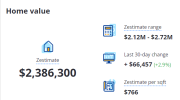Why don't companies like Zillow hire an appraiser to conduct brief site inspections to address "Condition." The minimal fees to hire appraisers presumably would be valuable because of the enhanced reliability of the AVM results.
Hmmm. In my opinion that would certainly be worth something. However, based on my experience, you need an appraiser who can "talk to" the regression and debug it when the models it produces don't make sense. Oftentimes, you wind up patching or appending to the data to make the regression tool generate a reasonable model. If the regression software is greek to the appraiser, he can't fix things. And the regression software certainly doesn't know anything about appraisal.
An advanced appraiser, or valuation engineer, at least in this day and age with almost no specialists in the field except a handful, has to be a jack of many trades to get things done - because only he can tie everything together to make sense of the whole.
It's actually like that in a number of fields where different specializations have to be mastered and "interfaced." My son-in-law, who has a Ph.D. in Geostatistics from Stanford is always saying he works at the interface between X, Y, Z, .... I think, if I recall correctly, it's the interface between Geology, Petroleum Engineering, Statistics, Green Energy, AI ....
I have to work with:
1. Statistics (principally MARS aka R/earth).
2. Data Collection, Management and Analysis - or simply Data Mining.
3. Inspection which includes photography (standard plus drone), mapping, measurement, floorplans, GIS, ....
4. Report writing
Don't forget all the gadgets you have to master and refresh yourself on. These are not simple, and you can eventually forget what the various icons and settings do or how to calibrate them. I've just given up on my old Canon 5D Mark II because the focus is simply not good enough anymore - and there is almost no one around to fix a camera this old. Canon won't take them any longer. So, I'm moving to the mirrorless R6 - which will still take my old Canon lenses (the 16-35mm f2.8L, 100-400mm IS, 28-70mm f2.8L, ....). In fact with the EOS-R circular ring adapter, you can use the old EF lenses the same way as the new R lenses - which is pretty cool. I can still keep the 5D as a backup. It is just that I am not hat happy with its performance any more. There is also the "simple" X4 which I bought a couple of months ago. I still have to drill myself on getting things done with it quickly. Then there is the Phantom IV drone, which is a fairly complex device.
--- But the truth is most of my time is spent with MARS, the R scripts and cleaning up or appending the data until I get something I am happy with. The latest thing I did was split up the swimming pool description into 4 fields which I input into the regression:
A. PoolYN? 0=No, 1 = yes
#1: AboveGround? 0= No, yes = 1
#2: InGround? 0=No, 5= Yes
#3: Gunite? 0= no, 1= yes
#4: Heated? 0=no, 1= yes.
I did the above using an Excel Macro like: =IF(IFERROR(FIND("Gunite",AQ2)>0,0)>0,1,0) where AQ is a column with values like:
| "Pool - Yes, Pool - In Ground, Pool - Gunite, Lap Only, Pool - Cover, Other, Pool - Sweep, Pool/Spa Combo, Heated - Solar, Spa/Hot Tub" |
B. PoolScore: Is the sum of the #1-#4, which can be: 0,1,2,5,6,7
I enter the variables A and B into the regression. ... And that was the final step that completed the model to my satisfaction.









